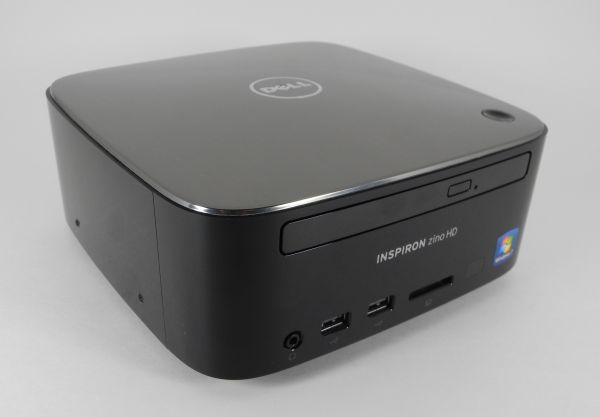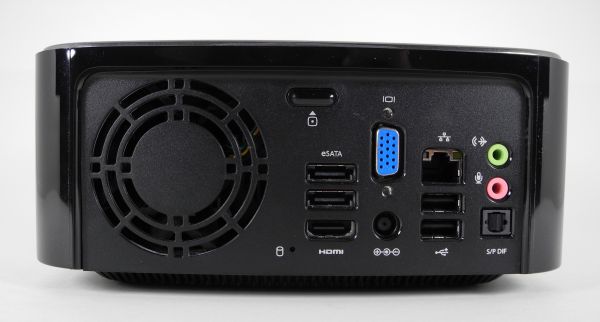Dell Zino HD 410 HTPC Review
by Ganesh T S on February 19, 2011 7:08 AM EST- Posted in
- HTPC
- Dell
- AMD
- Media Streamer
- ATI
Unlike the ASRock Core 100 / Vision 3D, the Zino 410 HD ships with a wireless keyboard and mouse. The packaging is, therefore, appropriately bigger. Apart from the main Zino 410 unit, the package also contains:
- 90W AC / DC Adapter
- Wireless keyboard and mouse with batteries
- USB RF receiver for the wireless keyboard / mouse
- Media Center remote
- Black lid (to replace the silver lid present on top of the unit by default)
- Support CD and warranty information booklet
Of all the SFF HTPCs I have seen, the Dell Zino 410 HD HTPC has the best industrial design. The contours are quite pleasing and the unit blends in quite nicely with the rest of the AV equipment.
The front panel is taken up by a tray loading Blu-Ray drive on top and a headphone jack, couple of USB 2.0 ports, SD card reader and the IR receiver at the bottom. The power switch is on the top panel.
The left half of the rear panel is taken up by the cooling fan. A press switch to displace the lid is provided at the top and a hard drive activity light is at the bottom. Other ports on the rear panel include 2 eSATA, 1 HDMI 1.3a, 1 VGA, 1 Gigabit Ethernet jack, 2 USB 2.0, a mic/headphone jack, optical SPDIF and the power adaptor connector.
The Zino 410 HD is raised with rubber bushes, and also has ventilation slots on all four sides, as can be seen in the picture above.
Just like a notebook, this unit also supports simultaneous display on two monitors. Testing was done mostly with the HDMI output connected to a Toshiba REGZA 37" 1080p TV through an Onkyo TX-SR 606. For non-media playing related testing, the VGA port was connected to an Acer H243H 1080p monitor.
Our review unit shipped with Windows 7 x64 Home Premium and a OEM version of Cyberlink PowerDVD for Blu-Ray playback.
We will conclude this section with a table to summarize the data and A/V connectivity options for the Zino 410 HD HTPC.
| Option | Status |
|---|---|
| HDMI | Yes [v1.3] |
| Component | No |
| Composite | No |
| VGA | Yes |
| SPDIF | Yes [Optical] |
| Stereo | Yes |
| Option | Status |
|---|---|
| Optical Disk Drive | Yes [Blu-Ray / DVD-RW] |
| USB | Yes [4 x v2.0] |
| eSATA | Yes [2x] |
| LAN | Yes [ 1000 Mbps GbE ] |
| Internal HDD | Yes [ 750 GB ] |
| WiFi | Yes [ 300 Mbps 802.11n ] |
| Card Reader | Yes |













69 Comments
View All Comments
silverblue - Saturday, February 19, 2011 - link
...would having two differently-sized SO-DIMMs have on system performance?I'd be tempted to take replace that 4GB module with a 2GB one just to see what happens. 6GB of RAM just doesn't compute. :)
We seem to be getting a decent number of Dell-AMD systems lately... I only hope they take up Brazos with the same level of enthusiasm, because even if it did result in a small drop in performance, this review would've been largely the same in terms of gaming and video playback/quality, albeit with a much smaller footprint. Also, in that scenario, dual channel wouldn't matter as Fusion doesn't support it.
fabarati - Saturday, February 19, 2011 - link
If AMD has anything like Intels asynchronous dual channel, the first 4 GB will perform like dual channel, whilst the remaining 2 GB will perform like single channel.Taft12 - Saturday, February 19, 2011 - link
Dual-channel memory was a scam from the beginning that has somehow survived to this day to make PC buyers think they needed to buy more memory than needed.Have you seen the benchmarks? ~1-2% benefit AT MOST for anything that's not a synthetic memory bandwidth test, regardless of platform.
http://www.tomshardware.com/reviews/PARALLEL-PROCE...
fabarati - Saturday, February 19, 2011 - link
Didn't it help back in the P4 and/or P-M days? And how did it do in early Athlon 64 days?But yeah, Core Duo and newer doesn't really benefit from Dual channel, one
silverblue - Saturday, February 19, 2011 - link
Theoretically, dual channel would help APUs as they're bandwidth-limited.I suppose you're right about standard usage though, even raising memory clocks doesn't make for a sizeable performance advantage.
asmoma - Saturday, February 19, 2011 - link
Starcraft 2 is not a synthetic memory test, and it does benefit from going from 2 to three channels, just read some performance reviews of Starcraft 2.DanNeely - Saturday, February 19, 2011 - link
The einstien@home applications benefitted from a 3rd channel on i7 quad cores; and the 2nd channel on C2 quads as well; high performance server farms/clusters/super computers are a significant segment of the market. On the i7-quad, E@H had a 66% speedup from the 2nd channel, and a 5% gain from the 3rd. Sandybridge gave a similar speedup from the 2nd channel. I can't find the thread with the C2Quad results, but IIRC they were a 10-25% speedup.http://einstein.phys.uwm.edu/forum_thread.php?id=8...
I don't have benchmarks handy, but I suspect a heavily loaded DB server would also benefit from the extra memory bandwidth because the queries would result in a psudorandom memory access pattern that would limit the ability of the cache controller to prefetch most of the data being requested.
jeremyshaw - Friday, March 4, 2011 - link
that actually had to do with uncore clocks, not memory channels.vailr - Saturday, February 19, 2011 - link
How would a Mac Mini compare?Could a Mac Mini be retrofitted with a Blu-Ray drive (since Blu-Ray is available factory installed) and then run as a Windows HTPC?
tipoo - Saturday, February 19, 2011 - link
Why on earth would you buy a Mini to run as a Windows HTPC? You'd pay more for less performance.